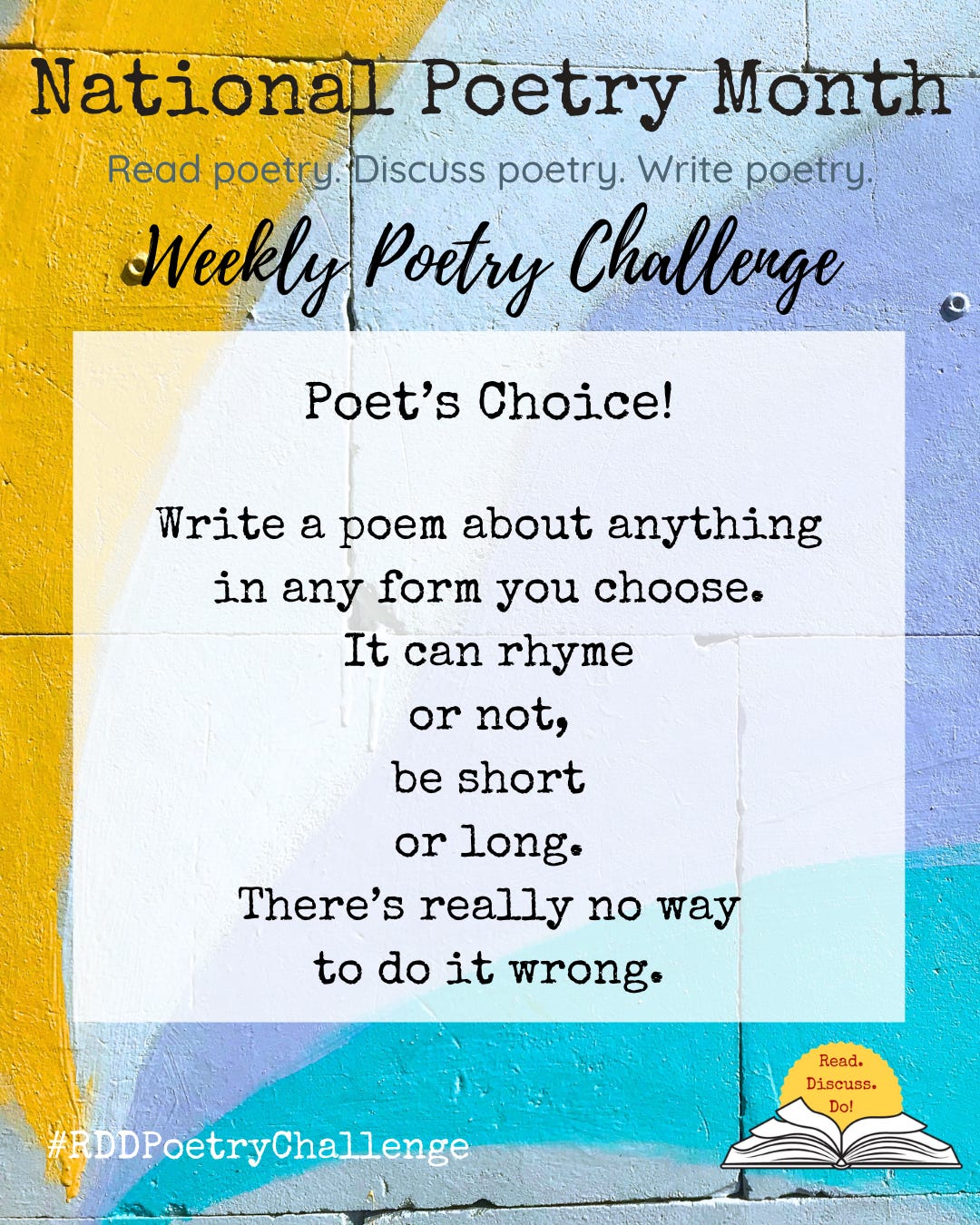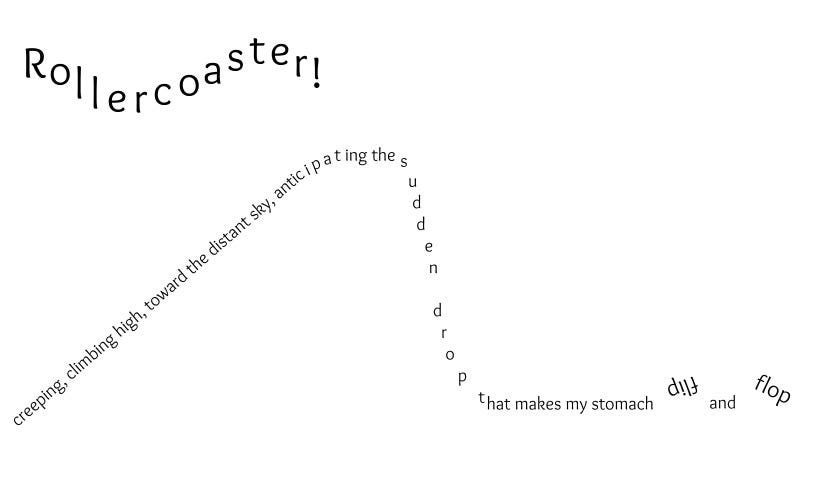Weekly Poetry Challenge Week Four: Poet's Choice
Read and write any kind of poem this week!
Welcome to Week Four of the Read, Discuss, Do Weekly Poetry Challenge! This week’s challenge is poet’s choice. We want to encourage you to read and write any kind of poem that you want. Is there a form you’re especially fond of? Something you’d like to challenge yourself with? Is your mind blank and you need a little nudge? Don’t worry. You’ll find some sample poems here, links to past themes, and a list of some of our favorite poetry collections for inspiration in case you need it.
Read: Any poems that you want! Grab a poetry book off the shelf, browse The Dirigible Balloon or Poetry4kids, or check out last year’s poetry roundup (it includes list poems, limericks, persona poems, and blackout poems). In case you don’t want to click away from this page, here are a few sample poems:
A concrete poem:
A limerick:
There once was a young girl named Tilly Who loved to act goofy and silly She played with her food Which was really quite rude And ended up covered in chili. by Rebecca J. Gomez
Free verse:
The March one by one I see them come stamping and tramping carrying loads of seeds and crumbs parading then fading into the ant hill by Rebecca J. Gomez
Discuss:
What do you think of poetry in general?
Do you have a favorite poetry form? How about a favorite poem? Favorite poet?
What is the hardest thing about writing poetry?
Do you prefer poetry that rhymes or that doesn’t rhyme?
Do you like it when poetry is easy to understand or do you enjoy poems that make you ponder? Or both?
Do: Write any kind of poem!
When setting out to write your poem, first decide what kind of poem you would like to write. Do you want to try a form that doesn’t rhyme, like haiku or free verse? Or would you like a rhyming poem, like a limerick or a poem written in rhyming couplets? Or maybe you’d like to write something that is visual, like a concrete poem or blackout poem.
Next, choose your poem’s topic. If you’re writing a haiku, your topic will probably be something in nature. If a limerick, your poem will be funny. If you want to try a blackout poem, you’ll “find” your poem in a selection of of text that has already been written, such as a newspaper article or a page from an old book.
Once you’ve chosen your topic, you may want to do a little brainstorming before you start writing your poem. It can help to create a list of words and phrases that come to mind when thinking about your topic. A rhyming dictionary could also be helpful if you want your poem to rhyme.
Then get to writing! Don’t worry about making your poem perfect right away. Even professional poets revise their poems.
Some Favorite Poetry Collections
Note: Some links will take you to the Read, Discuss, Do bookshop.org storefront. Purchasing a book from the storefront will support independent bookstores and help maintain Read, Discuss, Do at no additional cost to you.
A Stick Is An Excellent Thing: Poems Celebrating Outdoor Play by Marilyn Singer, illustrated by LeUyen Pham
This book is a fun romp of poems in different styles all celebrating outdoor play: from hopscotch, to jump rope, to walking around town, to using sticks with imaginative play. Enjoy these poems and be inspired to get moving outdoors!
Tap Dancing on the Roof, Sijo Poems by Linda Sue Park, illustrated by Istvan Banyai
This book of poetry utilizes sijo poems, which are a korean poetry similar to Haiku. They are traditionally three lines, but you’ll see in the book how sometimes one line is split into two in the book. The first line introduces the topic, the second line develops the topic further, and the 3rd line contains some kind of twist: humor, irony, puns, play on words, or unexpected words. These poems in the book are all done from a kid’s perspective.
This unique collection of animal poems is accompanied by the brilliant artwork of Eric Carle, the well-known author of A Very Hungry Caterpillar.
A Poke in the I, selected by Paul B. Janeczko, illustrated by Chris Raschka
A really fun collection of concrete poems (or shape poems) by various poets. This book includes a brief introduction explaining the various forms a concrete poem can take.
Poetry Comics by Grant Snide
A whimsical and thoughtful book that combines poetry with the visual elements of comics. This book takes the reader through all four seasons, exploring various ups and downs throughout the year. It’s a poetic and visual treat!
Outside Your Window: A First Book of Nature by Nicola Davies, illustrated by Mark Hearld
This oversized book of poems includes poems about a wide variety of things in nature, from sea shells to chickens! The large size is great for young hands, the mixed media illustrations are a feast for the eyes, and the poems are written in various forms and lengths. A great choice for readers of all ages!
Will you be writing poems this week? If you do, we’d love to see them! You can reply to this message, email us, or tag us on Instagram (use the hashtag #RDDPoetryChallenge or #RDDPoetryMonth). We will be sharing some readers’ poems in a round-up post at the end of the month, so if you’d like your poems to be considered, please let us know when you send them.
Next week we will be sharing a Poetry Challenge Round-up. If you’d like us to consider including your poems, please send them to us by Sunday, April 27.



